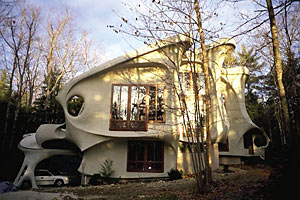February/March 2011
By Joshua Lobkowicz
Banks blink. Assessors scratch their heads. How do you establish a value for one-of-a-kind houses that are both lovable and wacky-doodle?

Congratulations! You’ve just built a magic house that looks like it’s made from dollops of whipped cream. Yes, but will buyers love it? There’s no way to determine its value.
Or maybe you’re trying to insure a house that’s covered in slate–everywhere, not just the roof… How can anyone get a bead on this incomparable home?
Looking for a bank loan to help you complete your underground Hobbit Hole that looks as though it’s straight out of Lord of the Rings? “It’s incomparably cool,” the bank’s appraiser says, “but perhaps a bit eclectic.” And therein lies the problem, Bilbo Baggins. It’s easier to take the Precious from Gollum than it is to get the recalcitrant real estate valuation schematics to put a price tag on originality.
Particularly if your home is made of a cutting-edge Green material that’s not the expected kind of cutting-edge Green material.
Well before the Three Little Pigs cut their first deal with Freddie Mac, the market has been suspicious of a house made of straw.
“My house in Beals is made of straw bales,” quips Robert Patterson. “It’s best suited for year-round living. Due to the thick walls and a lot of lime plaster on the inside and outside, it changes temperature very slowly.”
His environmental readings and low heating costs are sensational; he only has to run a wood heater for short periods of two to three days in the winter. Extraordinary at night, the house delights and surprises the eye like a postmodern hunk of Swiss cheese.
And what was his reward for daring to be different? “There was definitely some talk that ‘someone was building a strange house’ in the neighborhood,” he says. “I knew of the problem [of getting a mortgage] before we built. Since I did a large part of the work, the dollar investment was not very large, so that was not a hardship.”
“People who want to build an alternative home often have a vision of what that’ll be like, but when it comes time to construct it, they have trouble getting mortgages. They usually end up going after private money or using their own. A bank is just not going to do it,” says Tom Landry of Benchmark Realty.
Mortgage consultant Jeff Hess agrees. “The fact that they are incomparable can be the biggest stumbling block for a lender. The bank’s concern is whether or not they could sell the home, and this is true of any unique property, regardless of how smart or energy saving, because the potential audience is so much smaller.”
And it’s not just contemporary houses, either. John Calvin Stevens’s Horace F. Farnham House at 318 Brighton Avenue has dumbfounded onlookers for years for its 100-percent pink slate exterior. Just because the original owner who built this mansion in 1902 was a local building materials magnate and no doubt had connections to get the slate, how hard is it for 21st-century owners to keep it in good nick? Appraised for $616,000 by the city of Portland, who knows what its market value might be if it weren’t sheathed in such a rare, expensive coat?
Jim Sysko, owner of the Tolkienesque underground house in Newry, makes no such claims to tradition with his creation. “A snow mound was actually the original frame for the house. We covered it with sawdust and plastic so it wouldn’t melt; then we started applying concrete.” The result is a quiet, energy-efficient, two-bedroom, two-bath, dome-shaped house, nestled into a hillside. “It’s warm in the winter and cool in the summer. It’s everything you want a house to be.”
Except appraisable. And even if you can get financing, you have to deal with subcontractors shaking their heads.
“I had an exterminator once who was both terrified and enraged at the sight of it–‘What kind of house is this? I can’t exterminate this!’ He practically fled,” says architect Marcia Wake of her curvaceous Sculpture House, hidden away in the Windham woods. “It’s almost traditionally wood framed,” she says, though the walls, inside and out, have all been hand-plastered into smooth, swooping surfaces.
Considering the difficulties encountered by these ‘incomparables’ as a whole, what does it say about our institutional inability to accept change or even a fabulous new idea?
“It doesn’t have to be a new idea,” says Wiscasset’s Roy Farmer. “I had a devil of a time selling a historic water view home made of bricks that just happened to be shaped like an octagon,”–the Capt. George Scott House, built in 1855.
You can imagine the potential buyers responding to the unconventional room sizes: ‘Where could I put the entertainment center with our 96-inch flat-screen TV’? The first brick comparable that comes to mind is designed by Thomas Jefferson in southern Virginia–his retirement mansion, Poplar Forest. Value: priceless.
So in these dark woods you do the best you can. “When it comes to appraisals, we need to go out and find homes that are as comparable as possible,” says Chris Karageorge of Beacon Appraisals. “In Maine, that isn’t easy–especially with homes that are very unique unto themselves.” So how do appraisers figure it out when it comes to a home with straw walls or bedrooms beneath six feet of earth? “We pick key features and try and find them in other properties to demonstrate that that facet is comparable; we look at shape and size, bedroom count, location, etcetera. Sometimes when dealing with a unique home you need three, four, five, or more comparables.
“Some appraisers are intimidated by that process,” Karageorge says. “And lenders often don’t want to pay the fee that is appropriate to appraise a unique home which needs multiple comparables to value.”
Worse than that, Hess says, is, “A lot of lenders set overall policies to shy away from homes with non-traditional qualities.”
It doesn’t matter, then, that these homes are super energy-efficient?
“People can be very myopic when it comes to solving the energy crisis,” says real estate agent Avery Caldwell. “This is Maine after all, not San Francisco.”
Either way, we’re still in America. As Hess puts it, “Lenders will have to open up to follow the trend or risk losing out on that market.”





0 Comments
Trackbacks/Pingbacks